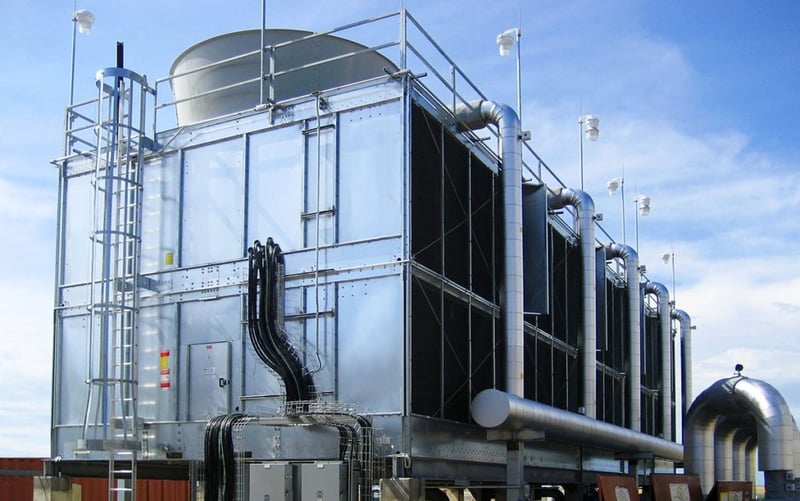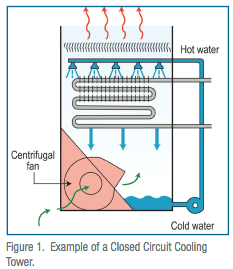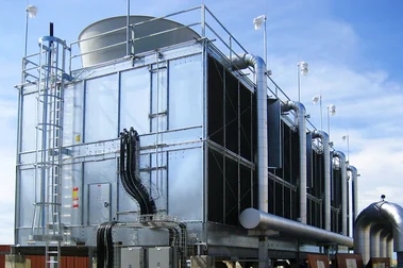Cooling towers are used to remove heat from a building. Cooling a stream of water to a lower temperature using evaporation does this. Large cooling towers are usually used in industries like power plants, petroleum refineries and various manufacturing facilities. They vary in size from large hyperboloid structures to smaller ones on the rooftops of shopping centers, hospitals or universities.
However, the most common application of a cooling tower is inside an HVAC system for cooling buildings.
An HVAC (heating, ventilating, and air conditioning) cooling tower is used to dispose unwanted heat from a chiller. HVAC use of a cooling tower pairs the cooling tower with a water-cooled chiller or water-cooled condenser.
Cooling towers vary in size and design based on the cooling load of a building. The cooling load is determined by the size of a building from which heat needs to be extracted. The other factor that affects this design is the relative humidity of the air. This is determined by the location of the building. For example, the relative humidity in Albuquerque, New Mexico is much lower than in Atlanta, Georgia.
Below are few examples of cooling towers:

Types of cooling towers:
Cooling towers are generally classified either by build, heat transfer methods and airflow generation methods. We will take a look at each of the types of cooling towers.
1. Cooling towers by build:
- Package type: Package type cooling towers are pre-fabricated. The shell is usually made of corrosion-free, heat resistant and durable material like fiberglass-reinforced polyester. Since they are pre-assembled, they can be easily transported to a facility of choice. Since they are compact, they are preferred in facilities with low heat rejection requirements like hospitals, malls, and office buildings.
- Field erection type: These are large units that are generally used in power plants, huge manufacturing facilities such as steel processing plants or oil refineries. They are large structures compared to the package type. They can be manufactured according to custom specifications.
2. Heat transfer methods:
- Dry cooling towers: Dry cooling towers operate by transferring heat through a surface that separates the working fluid from ambient air. This operates on the principle of heat transfer by a heat exchanger with extended fins. The fan is driven by an electric motor. Hence, dry cooling towers don’t consume any water.
- Wet cooling towers or Open Circuit cooling towers: These are the most popular cooling towers because they are cost-effective and renewable. They use water to cool the facility and the heat transfer is measured by the decrease in the process temperature and a corresponding increase in both the moisture content and the wet bulb temperature of the air passing through the cooling tower.
- Wet cooling towers typically produce drift emissions. Although they are not hazardous to the environment, multiple drift eliminators are used to minimize the cooling tower drift. They evaporation of water in a wet-mechanical draft is inherently more energy efficient when compared to the other types of cooling towers like dry or fluid.
- Fluid cooling towers or closed circuit cooling towers: In closed circuit cooling towers, often water is mixed with glycol to form a fluid. This fluid circulates in a coil throughout the tower and is not directly exposed to the air. They are typically used where the surface needs to be clean and free of contaminants. The advantage is that there is no scale formation and hence makes for better productivity and lesser downtime.

Source: U.S. Department of Energy
3. Air Flow Generation Methods:
The types of cooling towers based on the air flow generation are Natural draft, Mechanical draft, Cross-flow and Counter-flow towers.
- Natural Draft cooling towers use the design and shape of the tower itself to move up the air naturally using fans. They use the law of different densities between ambient air and the warm air in the tower. Hence, these towers are tall to induce the airflow and are shaped like a “hyperbole”. They are typically located outside the buildings to allow for air flow.
- Mechanical Draft towers tend to use a fan to force the air. Propeller or centrifugal fans are used to circulate air inside the tower. These are much smaller in structure than natural draft towers. Capacity control is easy in these types of towers since the speed of the fan can be controlled. Unlike natural draft towers, these can be located anywhere inside the building.
- Cross Flow cooling towers are structured to allow air to flow horizontally while the water flows down vertically. This is done through open trough systems in the fan deck, fitted with nozzles. Since the airflow contact time is lesser, more air is required for heat transfer to occur. This type of cooling tower has many disadvantages such as higher power consumption due to the airflow required; maintenance is time consuming and is susceptible to scaling and clogging of openings.
- Counter flow uses hot water that enters at the top, while the air is introduced at the bottom and exits at the top. Both forced and induced draft fans are used. The distribution is done through channel with lateral pipes, fitted with splash spray nozzles. Growth of algae is highly restricted, as the lateral pipes are a closed unit and not located in direct sunlight. Their power consumption is lower than cross flow units and offers the advantage of easy maintenance.
Maintenance of cooling towers:
Routine operational maintenance is very important to achieve consistent throughput from your cooling towers. If you take a close look, most manufacturers include both good maintenance instructions as well as maintenance programs that could simplify both time and money for your operational expenses. These procedures can prevent loss of efficiency in the heat transfer section by maintaining proper water flow and airflow, as well as preventing corrosion in the cooling tower.
Maintenance frequency depends on the type of the tower, the size and external factors like geographical location of your building.
Some of the activities that you can perform are:
- Implementing strainer systems that act as filters to collect debris and minimize contact between air-borne or water-borne contaminants.
- Nozzles should be cleaned regularly to prevent clogging. Since nozzles enhance even water distribution, they should be placed where they can be easy accessed, inspected, cleaned or replaced.
- Water treatment options like water modeling, green chemical usage, filtration and softening ensures that the tower system operates optimally and achieves the needed cooling requirement. This is recommended to be done monthly unless otherwise specified by the manufacturer.
- Deep cleaning of the cooling towers involves using a cleaning chemical that circulates and flushes out of the system. Pressure washing and vacuuming also form a part of the deep cleaning process.
- Mechanical components like fans, motors and belts need to be inspected cleaned and adjusted, if necessary.
- Electrical components like capacitors and wiring should be inspected and replaced if necessary.
Cooling towers and energy efficiency:
With increasing prices of energy and emphasis on sustainable environment, it is important to ensure that the cooler towers are designed, built, installed and maintained in a manner that uses lower energy.
Some of the methods you can use to make efficiency improvements are :
- Water-cooled and open circuit systems consume lower energy than air-cooled alternatives.
- The cooling tower can be operated at full fan speed to allow the minimum condenser water temperature limit to be reached. Below this level, you can use a variable speed drive (VSD) to maintain a set point.
- Using a closer design approach for the cooling tower can lead to potential energy savings. The tower approach is defined as the difference between the water temperatures leaving the cooling tower minus the entering wet-bulb temperature. When a closer design approach is chosen, the resulting cooling tower provides colder water to the chiller condenser, even on a design day, which in turn reduces compressor energy.
- Fan Speed Control: According to the standards as defined by ASHRAE 90.1-2013, cooling tower fan speed must have the capability to be controlled proportional to the leaving fluid temperature or condensing temperature/pressure. This is accomplished by either the use of two-speed motors or variable speed drive technology. This can be applied on both new and existing installations.
Conclusion:
In conclusion, cooling towers are an essential component of every building. It varies in size, shape and type depending on the building’s needs. Large facilities like power plants, oil refineries and steel manufacturing plans have hyperboloid units, while most other facilities have a cooling tower in their HVAC.
The routine maintenance of the cooling towers is very important to maximize their utilization. Since cooling towers consume energy, there are multiple ways you can ensure that they are energy efficient.



